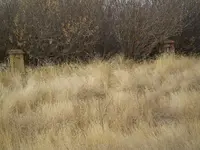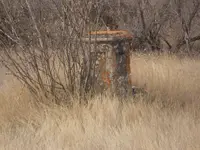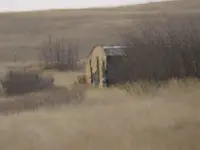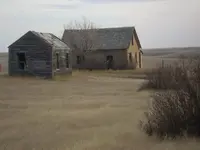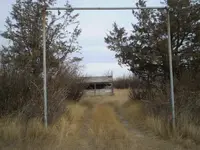discovery_bound
Full Member
- Joined
- Feb 4, 2008
- Messages
- 172
- Reaction score
- 1
- Golden Thread
- 0
- Location
- South Dakota, B&R in Montana
- Detector(s) used
- Tesoro Silver Umax
- #1
Thread Owner
So, I've been on and off T-Net for a little while and decided to concentrate on research instead of just lurking through all the posts. Not sure what to think of this place, but might as well give it a shot....what do you think? Sort of a lengthy read, but gives a good visual of the era. (oh, and yes I have unlimited permission!!!)
A Simple Place in Time... January/February 2007
Date Posted: February 19, 2007
Written by Barb Selyem. Photos by Bruce Selyem
The roads have no formal names here�a place where farmers give directions by section lines, farmhouses, and grain elevators.
An arrow on a crossroad fence points the way to Comertown, MT, and the railroad siding marks the place.
The houses are gone now�some moved, some burned, some slumped silently in thigh-high grass next to farm implements long hidden and forgotten.
There is an old, weathered railcar with broken windows and a few frayed curtains. A concrete stairway with massive posts sits unattached next to lilac bushes.
There are no businesses, no schools, and no churches; only a few shells of abandoned buildings remain.
The grain elevator�once a stately symbol of a prosperous community� rests in ashes on its foundation.
A Prospering Comertown
When the Soo Line Railroad arrived in Comertown in 1913, it carried with it visions of a much different future. Some settlers, enticed by railroad advertisements touting the fertile farmland of northeast Montana, homesteaded nearby.
Others who moved to town built hotels, schools, a hardware store, a livery, a grocery store, a post office, saloons, and lumberyards.
Grain handling. One early entrepreneur, George Onstad of Westby, MT, built the town�s first grain elevator.
It was a 12,000-bushel cribbed structure, with a manual manlift and a wood leg powered by a one-cyclinder gas engine. It stood alone along the tracks until 1916, when area farmers united to build the Farmers Elevator.
That year, Onstad sold to the Atlantic Elevator Co., a large and well-known grain conglomerate of that era. He could not have known that his elevator would continue to tower over the community for 87 years.
The Farmers Elevator burned in 1924, and in its place, the Occident Company, a division of Russell-Miller Milling of Valley City, ND built an 18,000-bushel cribbed facility. It also had a manual lift and a wood leg powered by a gas engine, and �Occident Flour, Cost More Worth It� was painted proudly on its side.
Eventually, Occident acquired the original 1913 Onstad elevator too and operated both until 1954, when Russell-Miller Milling, including its country elevators, was sold to the Peavey Co. of Minneapolis, MN. Jim Syme, an area farmer, purchased the Comerton elevators from Peavey.
Jim�s first manager was Don Fink, and his first bookkeeper was Zelda Fink, Don�s wife.
In 1957, Don and Jim moved the Onstad elevator closer to the larger Occident structure and turned it 90 degrees. They removed the manlift and leg and installed augers to and from the main house, thus transforming the old elevator into an annex. They replaced the �one-lung� gas engines with electric motors.
A Declining Comertown
Don and Zelda continued to work for Jim until 1960. By then Comertown was already declining and had closed its high school. The Finks, who had school-aged children, moved on to work for an elevator in Raymond, MT.
At that time, they had no idea that they would one day own the Comertown elevators themselves.
In 1977, Jim sold out to his brothers, Tim and Howard, who would use the facility to store and merchandise their own harvests.
Tim reflects positively on his involvement.
�The elevator had 18 bins, and it provided a very good system for handling grain,� Tim said.
�We could receive, ship, blend, clean, and move different types of grain, as the extra bins allowed for more types of storage,� Tim explained.
�The elevator still had its original Fairbanks scale and wagon hoist, and the flooring showed traces of how the horses would dig away on the platform trying to pull their loads.�
In the early 80s, Tim sold his share to Howard, who continued to ship by rail east to Minnesota and west to Washington and Oregon for a few years. Howards�s memories are not quite as pleasant as Tim�s.
Ultimately, Howard was forced to close the elevator in the mid-1980s, as competition from bigger grain companies drove independents out of business. The Comertown elevators were never used again.
Don and Zelda Fink, who had visions of renovating the elevator, bought the buildings in 1987 but never fulfilled their dream.
Two years later, Don and Zelda sold it to a nephew, Vic Johansen, who planed to move the elevator to his farm, near Antelope, MT. He never made the move, and in 1991-92, he allowed the railroad lease to lapse.
The Soo Line never forced the demolition or removal of the buildings, nor did the title of ownership ever change.
Elevator Fire
On June 23, 2000, the Comertown elevators burned to the ground. The fire was so intense that it could be seen 12 miles away in Westby, MT.
No effort was made to save the buildings and though lightning was cited as the cause, no final determination was ever made. Now, only the rubble remains.
On a summer day, if you perch on those massive concrete stairs that lead nowhere, you can hear the sounds of the wind as it stirs the long grass and turns the old, sqeaking windmill across the road.
You will hear the popping of the tree-high carragana bushes as they spread their seeds, the hollow cooing of the mourning doves, and the flutelike songs of the meadowlarks. If you are very still, you can imagine the sounds of past generations as they worked, played, and prayed together.
And, you may lament the passage of a simpler time
A Simple Place in Time... January/February 2007
Date Posted: February 19, 2007
Written by Barb Selyem. Photos by Bruce Selyem
The roads have no formal names here�a place where farmers give directions by section lines, farmhouses, and grain elevators.
An arrow on a crossroad fence points the way to Comertown, MT, and the railroad siding marks the place.
The houses are gone now�some moved, some burned, some slumped silently in thigh-high grass next to farm implements long hidden and forgotten.
There is an old, weathered railcar with broken windows and a few frayed curtains. A concrete stairway with massive posts sits unattached next to lilac bushes.
There are no businesses, no schools, and no churches; only a few shells of abandoned buildings remain.
The grain elevator�once a stately symbol of a prosperous community� rests in ashes on its foundation.
A Prospering Comertown
When the Soo Line Railroad arrived in Comertown in 1913, it carried with it visions of a much different future. Some settlers, enticed by railroad advertisements touting the fertile farmland of northeast Montana, homesteaded nearby.
Others who moved to town built hotels, schools, a hardware store, a livery, a grocery store, a post office, saloons, and lumberyards.
Grain handling. One early entrepreneur, George Onstad of Westby, MT, built the town�s first grain elevator.
It was a 12,000-bushel cribbed structure, with a manual manlift and a wood leg powered by a one-cyclinder gas engine. It stood alone along the tracks until 1916, when area farmers united to build the Farmers Elevator.
That year, Onstad sold to the Atlantic Elevator Co., a large and well-known grain conglomerate of that era. He could not have known that his elevator would continue to tower over the community for 87 years.
The Farmers Elevator burned in 1924, and in its place, the Occident Company, a division of Russell-Miller Milling of Valley City, ND built an 18,000-bushel cribbed facility. It also had a manual lift and a wood leg powered by a gas engine, and �Occident Flour, Cost More Worth It� was painted proudly on its side.
Eventually, Occident acquired the original 1913 Onstad elevator too and operated both until 1954, when Russell-Miller Milling, including its country elevators, was sold to the Peavey Co. of Minneapolis, MN. Jim Syme, an area farmer, purchased the Comerton elevators from Peavey.
Jim�s first manager was Don Fink, and his first bookkeeper was Zelda Fink, Don�s wife.
In 1957, Don and Jim moved the Onstad elevator closer to the larger Occident structure and turned it 90 degrees. They removed the manlift and leg and installed augers to and from the main house, thus transforming the old elevator into an annex. They replaced the �one-lung� gas engines with electric motors.
A Declining Comertown
Don and Zelda continued to work for Jim until 1960. By then Comertown was already declining and had closed its high school. The Finks, who had school-aged children, moved on to work for an elevator in Raymond, MT.
At that time, they had no idea that they would one day own the Comertown elevators themselves.
In 1977, Jim sold out to his brothers, Tim and Howard, who would use the facility to store and merchandise their own harvests.
Tim reflects positively on his involvement.
�The elevator had 18 bins, and it provided a very good system for handling grain,� Tim said.
�We could receive, ship, blend, clean, and move different types of grain, as the extra bins allowed for more types of storage,� Tim explained.
�The elevator still had its original Fairbanks scale and wagon hoist, and the flooring showed traces of how the horses would dig away on the platform trying to pull their loads.�
In the early 80s, Tim sold his share to Howard, who continued to ship by rail east to Minnesota and west to Washington and Oregon for a few years. Howards�s memories are not quite as pleasant as Tim�s.
Ultimately, Howard was forced to close the elevator in the mid-1980s, as competition from bigger grain companies drove independents out of business. The Comertown elevators were never used again.
Don and Zelda Fink, who had visions of renovating the elevator, bought the buildings in 1987 but never fulfilled their dream.
Two years later, Don and Zelda sold it to a nephew, Vic Johansen, who planed to move the elevator to his farm, near Antelope, MT. He never made the move, and in 1991-92, he allowed the railroad lease to lapse.
The Soo Line never forced the demolition or removal of the buildings, nor did the title of ownership ever change.
Elevator Fire
On June 23, 2000, the Comertown elevators burned to the ground. The fire was so intense that it could be seen 12 miles away in Westby, MT.
No effort was made to save the buildings and though lightning was cited as the cause, no final determination was ever made. Now, only the rubble remains.
On a summer day, if you perch on those massive concrete stairs that lead nowhere, you can hear the sounds of the wind as it stirs the long grass and turns the old, sqeaking windmill across the road.
You will hear the popping of the tree-high carragana bushes as they spread their seeds, the hollow cooing of the mourning doves, and the flutelike songs of the meadowlarks. If you are very still, you can imagine the sounds of past generations as they worked, played, and prayed together.
And, you may lament the passage of a simpler time



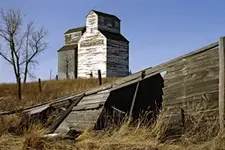
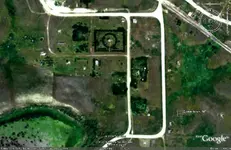
 I'm just kidding.
I'm just kidding.